We carry quartz sleeves and all parts for ETS, Aquafine, Ultra Dynamics, Trojan UV, Atlantic UV and Wedeco systems.
We carry Dow/Filmtec, Hydranautics, Osmonics, Desal, Koch, Toray and TriSep replacement RO membranes.
We carry filters for microfiltration, ultrafiltration and nanofiltration specifications from several suppliers.
In-stock items usually ship the same day. If we don't have some obscure part in stock, we'll try to track one down for you.
Whether you need valves, pumps, motors, gauges or any manner of replacement parts, you want us to be your first call.
Wendy Quinn started her water filtration parts business in 1986 with an initial focus on the semiconductor industry.
The importance of water quality in beer production cannot be understated since it makes up around 95% of beer and accounts for much of the flavor and perceptions of any beer. Creating the various regional tastes associated with a particular locales natural water source while maintaining uniformity of flavor, purity and freshness of a particular brew is a science in itself.
Local tap water that lacks the desired mineral concentration, or which contains undesirable elements such as too much chlorine, tends to lack the quality and consistency needed for optimal brewing.
Inevitably, the production and processing of high quality water is a critical factor, due to its influence on both the production process (mashing/wort composition, fermentation) - for example, yeast requires mineral elements such potassium, sodium and calcium for optimum fermentation – and on the taste of the final product.
It is therefore important that the brew-master properly treat his beer-brewing water so that all unnecessary contaminants are first removed. This includes chemical contaminants such as chlorine, chloramine, pesticides and heavy metals as well as ions such as sodium, calcium, magnesium, sulfate, chloride and bicarbonate.
Breweries therefore focus a lot of attention on both sourcing this raw material and on its quality since water must be clean from biological, physical, and chemical contamination in order to be suitable for brewing.
For centuries, diatomaceous earth, a fine silica clay made from the exoskeletons of microscopic diatoms was used to filter yeast from the beer in the clarification process. One factor driving the use of reverse osmosis (RO) water purification systems for brewing was that this material has a very limited lifespan and represents a major waste stream for breweries.
While diatomaceous earth, plate and frame, or rotary filters were traditionally used to filter the beer prior to packaging, water consumption was high with these technologies. Newer alternatives include cross-flow or membrane filtration.
Around 2002, several companies developed alternatives to diatomaceous earth with their membrane filtration and ultra-filtration technologies, such that Beer Membrane Filtration (BMF) has all but replaced diatomaceous earth as the most effective method for removing the largest spectrum of contaminants in beer brewing facilities, regardless of whether it is a homebrewer or one of the largest brewing operations in the world.
Before water enters a brewery reverse osmosis system, chlorine and other organics must be removed by a back-washing carbon filter and if the water contains iron/manganese or sulfur (sulphur), it must also be removed. If the water is over 4 or 5 grain hard (over 70 mg/l hardness), then a water softener or anti-scalant must also proceed the reverse osmosis system.
After the water is processed through the reverse osmosis system it is often stored in an atmospheric storage tank that is from 300 gallons to up to 2,000 gallons in capacity, depending on the size of the microbrewery. A microbrewery is a brewery that produces less than 15,000 barrels (17,600 hectoliters) of beer per year.
Occasionally, some brewers opt to put the water from the RO system through a deionization (DI) system which results in absolutely pure water with a pH of 7.0, but this is seldom recommended.
After the storage tank, there is a re-pressurization pump that delivers the water to the desired sources at approximately 60 PSI up to 16 GPM. In order to prevent any water or airborne bacterial contamination, an in-line ultraviolet (UV) light destroys any bacteria.
There also may be a 0.2 micron final filter, just for safety, along with a variety of monitoring equipment and water analysis options to continually or periodically test your water quality.
The mineral content of your source water is going to have a definite effect on pH, enzyme activity, hop perception, and clarity of finished beer.
According to MoreBeer.com any discussion of beer making water treatment must be prefaced with an understanding of the principles of pH, hardness, and alkalinity. pH is a measure of relative acidity or basicity; hardness is a measure of the total calcium and magnesium ions in solution; and alkalinity, in this context, is a measure of the water’s buffering capacity.
All three variants are interconnected, interrelated, and intimately tied to the mineral profile so they should all be considered in conjunction with any treatment program because they will have a significant effect on how the treatment is to be performed.
What complicates matters is that different steps in the brewing process require different pH ranges.
Brewing water, for example, is best kept at a pH range of 6–7. The mash should be kept within pH 5.2–5.5 (at mash temperature) for optimal enzymatic action. In wort, proper pH is important for coagulation of proteins; during fermentation, the optimal pH will promote a good environment for yeast, but an unwelcome environment for bacteria. The finished beer pH should fall between 4 and 5.
The term “hardness” describes water with which it is hard to generate a lather from sodium-based soap, not that you want to bathe in beer. Hard water makes lathering difficult; soft water (or the lack of hardness) makes lathering easy. Hardness is defined technically as the total concentration of calcium and magnesium dissolved in solution.
Alkalinity is a measure of the buffering capacity of the anions in solution, and, with pH, can complete the chemical picture of your water. A buffer prevents changes in pH by maintaining a relatively constant concentration of hydrogen and hydroxide ions within a certain pH range. Bicarbonate is a strong buffer and the major component of the alkalinity of brewing water; the relationship between alkalinity and hardness is apparent.
Raw water purity, microbial stabilization, air and gas sterility, yeast and bacteria removal, clarification, sterilization and final filtration are vital to maintaining that balance. Contaminants such as particles, crystals, treatment residue, organic aggregates, bacteria and yeast can jeopardize the beer’s taste.
What's most important to the brewer is the effect the brewing water has on mash pH. Malt enzymes are very particular about temperature and pH, and mashing is essentially an enzymatic process. Proper mash pH, usually preferred at around 5.2-5.4, can be achieved by several means. In the early days of brewing, methods were mostly limited to malt composition and biological acidification. Modern breweries may add food grade acids such as lactic acid or phosphoric acid to adjust the mash pH.
There are many subtleties to managing the ion balance. While it's essential to keep the mash in the right pH range by whatever means, the presence of certain minerals does have an effect on flavor and character of the beer.
Many minerals have a positive effect on brewing up to a point, after which they're detrimental, causing excessive saltiness, sourness or bitterness. Yeast requires a proper balance of calcium (Ca) with magnesium (Mg) for optimal fermentation along with several other nutritional requirements.
Brewing beer is a complicated process, combining craft and science. Reverse osmosis is a critical element of this system since it provides the brew-master with the highest quality raw material upon which he or she can perform their craft.
However, absolutely pure filtered water processed through reverse osmosis would not make very good brewing water. Fortunately the brewer can add back minerals during the brewing process stages in order to suit any style of beer he or she is trying to create or duplicate.
Brewers can, in fact, work their mastery and brew beyond the limitations of their local water supply in order to create excellent beers of any style or regional flavor. In most cases it takes only a few simple changes to the mineral content of your available feed water supply to create a medium that will bring out the unique beer flavors you’re aiming for.
The quality and composition of your brewing water has as much influence on the overall quality of the final product as yeast selection and fermentation temperature. As with many advanced brewing methods, the first time experimenting may seem complicated, but as you get more comfortable “customizing” your water, the extra time spent on the calculations becomes as routine as preparing your yeast a few days before brewing.
If your local water supply is fairly soft, or your brewing water has been treated to remove or reduce undesirable minerals through one of the methods mentioned above, the water is now ready to be further adjusted by the addition of mineral salts.
There are a variety of minerals (also called “brewing salts”) and other water treatment aids that help small localized brewers find that perfect match and maintain consistency in their water, which means consistency in beer.
Many breweries utilize a calcite filter which adds a small amount of calcium carbonate back to the water for flavor and to raise the pH. There are also injection systems which can inject soda ash or other brewing salts and ingredients such as gypsum, calcium chloride, epsom salts, slaked lime, baking soda or chalk into the water to achieve the desired pH or mineral levels. Some home brewers, after running a brew calculation spreadsheet, do their water adjustments manually with just a sprinkle or spoonful of this and that.
Brewing aids such as Water Treatment, Enzymes, Colloidal Stability, Flavor Stability, Wort Clarification, Beer Clarification, and Foam Control are critical aspects of taking a beer from unfermented wort to stable and proper pints.
Despite significant improvement over the last 20 years, water consumption and wastewater disposal remain environmental and economic hurdles that directly affect breweries and the brewing process.
While decades ago breweries would have used perhaps six or even seven litres of water per litre of beer, there has been a general trend for breweries to use five litres or less. Some large operations are looking at a target of less than four and many craft brewers are world leaders with ratios below three to one.
The Brewer's Association Water and Wastewater: Treatment/Volume Reduction Manual is an excellent resource for evaluating effective water and wastewater management solutions in the craft brewer segment.
The outlined solutions can apply to all breweries, regardless of location and operational size. It provides guidance for small brewers that are just beginning to explore water and wastewater reduction programs, as well as offer new ideas for brewers that are looking to improve a well-established program, or build improved efficiency into expansions or new facilities.
Brewers will also find tools they can easily incorporate to integrate water use reduction and conservation measures into everyday operations and identify on-site wastewater treatment opportunities.
Beer is about 95% water in composition; however, the amount of water used to produce a container of beer is far greater than the amount of water contained in the beer that is actually packaged and shipped out.
Although water usage varies widely among breweries and is dependent upon specific processes and locations, the U.S. average is about seven barrels of water for every barrel of beer produced. While a few craft brewers use well water as an alternative source, most receive their water from municipal suppliers.
In addition to the water used in production, wastewater generation and disposal presents another improvement opportunity for brewers. Most breweries discharge 70% of their incoming water as effluent. Effluent is defined as wastewater that is generated and flows to the sewer system.
Not many craft breweries have a dedicated on-site wastewater treatment system so most just discharge their effluent to a municipal treatment center. In most cases, brewery effluent disposal costs are much higher than water supply costs.
In many communities, breweries may be the largest consumer of water and the largest source of organic effluent that must be treated by the municipal treatment plant. This presents unique supply and cost concerns. In the U.S., the cost of incoming water from a municipal supplier (tap fee) is relatively inexpensive compared to other brewery utilities. When combining that cost with treatment (physical and chemical) and effluent disposal costs, brewers are presented with a reflection of the true or full cost of water.
From a cost perspective, it is important to reduce water usage, not only by purchasing less water, but to reduce waste-water costs based on the amount of incoming water purchased. Although each brewery is different, breweries can generally strive to achieve an effluent discharge of about 3 to 5 liter of source water per liter of sold beer (exclusive of cooling waters).
Since most breweries are charged for their wastewater based on the incoming water purchases as well on the strength of the effluent, water management and wastewater minimization efforts make good business sense from both a cost savings and from a business continuity perspective.
Pressure driven membrane processes in the brewing industry are increasingly being applied in other processes such as caustic recovery and process and wastewater treatment. By recycling this wastewater in the cleaning and rinsing process, a brewery can increase production while reducing waste water charges.
The Clean Water Act regulates the discharge of pollutants into U.S. waters and establishes quality standards for surface waters. Under the Clean Water Act, the following rules may impact craft brewers and microbrew operations.
Common legal drivers under the Clean Water Act include:
In addition, the Safe Drinking Water Act (SDWA) sets legal limits on levels of certain contaminants in drinking water.
In addition to these regulatory guidelines, there are also regional compacts that can govern water use and wastewater effluent. There are groups (i.e., The Great Lakes Compact) working together to protect local watersheds. It requires all water-intensive businesses within the watershed to implement water conservation practices.
The fact that most microbreweries, apart from loving beer, also love the planet and its natural resources is exemplified in the following statement.
There are 4,414 breweries in the U.S. right now, more than there ever have been in our history. And we all rely on water. I don’t think that you would see this resurgence in craft brewing in the U.S. if it wasn’t for the Clean Water Act of 1972.Brewers for Clean Water and the Natural Resources Defense Council.
Wastewater pre-treatment is an important investment for green-conscious craft breweries.
On-site pretreatment can reduce the strength of the effluent being discharged and may be required by local authorities through ordinance or permit. Discharge limits are being applied more often to brewers because of the high organic load untreated brewery effluent may contain.
Fortunately, the effluent from the membranes can be reused in the brewery, in processes ranging from bottle/keg cleaning, service water to boiler feed water such that a re-use ratio of up to 50% is achievable. The Brewers Association's solid waste reduction and sustainability manual is a consolidated resource for effective solid waste management solutions in the craft brewers segment.
To prevent turbid particles, which are mainly yeast cells, from forming a "cake layer" on some filtration membranes a cross-flow is applied perpendicular to the beer flow through the pores in the membranes, which have a typical service life of 400 run-cycles before they need to be replaced.
Cross-flow filtration involves circulating the beer though a microfiltration cartridge containing a ceramic membrane. Yeast, bacteria, and other solids are retained on the membrane. This produces a thick yeast slurry that contains over 40% protein and can be suitable as an animal feed supplement. Since all bacteria are removed, no further pasteurization is needed.
One component of the waste in the brewing process is known as trub (protein and hops left in kettle), which is separated from the grains boiling process resulting in waste with significantly high total solid concentrations. This waste is difficult to treat using conventional biological systems due to the high suspended solids found in the waste, so it is typically hauled away for treatment at great expense to the brewery.
If the suspended solids can be removed, conventional biological systems could be able to treat the liquid portion, reducing treatment costs and even provide added revenue from the sale of the separated grains as an animal feedstock (though many craft breweries just give it away). While spent grain or trub and yeast slurry can be combined and sold as cattle feed, spent diatomaceous earth (DE) can be sent to local organic farmers for use as a soil amendment.
Tip: Do not mix residual wort with surplus yeast – the mixture will start fermenting and the value of both waste streams will be reduced. Fermentable matter needs to be kept separate to maintain its value as an animal feed and yeast needs to be kept separate to maintain its value for food manufacturers.
Two key components of pH neutralization systems include the following:
Brewery wastewater tends to gravitate towards a higher pH due to the amount of caustic used for cleaning. Low pH indicates increasing acidity while a high pH indicates increasing alkalinity (a pH of 7 is neutral).
If your craft brewery includes a brewpub, any water and wastewater issues associated with food and drink services must be addressed.
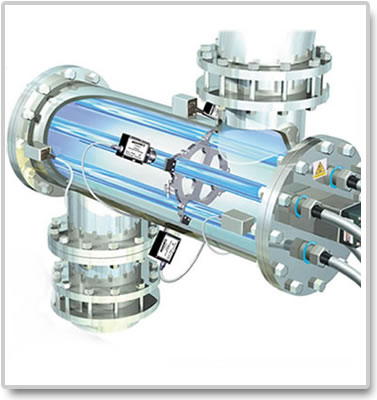
Ultraviolet (UV) treatment basically works in the same way strong sunlight purifies water by rendering any biological impurities inactive with certain lightwaves.
By destroying the very DNA of harmful pathogenic organisms, UV reduces the risk of contamination by preventing bacteria and viruses from being able to reproduce or perform vital cellular functions.
We supply replacement UV tubes, quartz sleeves and a variety of other parts from Neptune Benson/ETS, Aquafine, Ultra Dynamics, Trojan UV, Atlantic UV and Xylem/Wedeco.
Reverse Osmosis Systems use a process that reverses the flow of water in a natural process of osmosis so that water passes from a more concentrated solution to a more dilute solution through a semi-permeable membrane with a pore size of approximately 0.0001 micron. Pre- and post-filters are often incorporated along with the reverse osmosis membrane itself, especially for microelectronics, printed circuit boards and semiconductor production.
Western Industrial can supply your ultrapure water treatment needs with parts and membranes for the Filmtec, Hydranautics, GE Osmonics, Toray, Desal, Koch and TriSep line of products. Here's more info on the Science and Application of Reverse Osmosis for Wastewater Treatment.
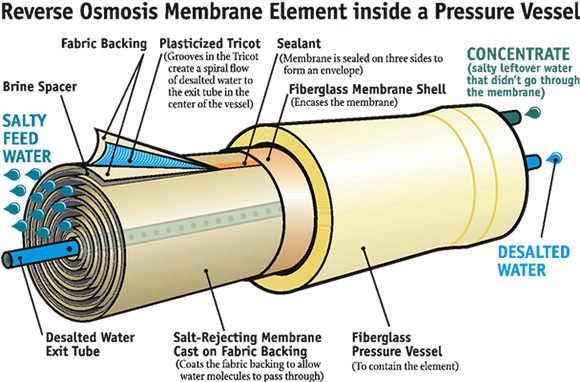
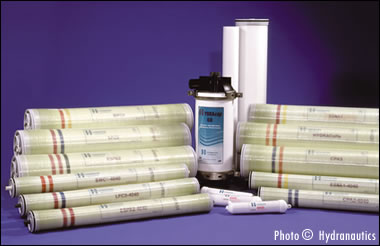
We can supply various water filter media such as diatomaceous earth, garnet, granular activated carbon, gravel, hematite, ilmenite, magnetite, manganese dioxide and sand.
To protect the filter’s membrane surface, pretreatment before filtration may include the addition of coagulants and powdered activated carbon, adjustments in pH or chlorine concentration levels.
We can supply you with instrumentation, Pentair control valves, ball-valves, butterfly-valves, needle-valves, floating-valves, gate-valves, forged-valves, check-valves, Y-strainers, joints and piping in brass, stainless steel or cast iron, plus pumps and motors from Grundfos, Goulds, Baldor, Wilden, LMI, Robusta, Kontro, Fristam, Fybroc, Jabsco, Paco, Pulsafeeder, Tonkaflo, Neptune, Walchem, Dayton, Hartell, Prominent, Ansimag, SIHI, Warrender, ARO, Little Giant and Torpedo.
Filtration is a physical process that occurs when liquids, gases or dissolved/suspended matter adhere to the surface or the pores of an absorbent medium which allows certain molecules to pass (ie. H2O).
The choice of decontamination method required for each commercial / industrial water use application depends on the amount, size and charge of the contaminant particle needed to be blocked.
Using membrane filtration technology, reverse osmosis offers the finest degree of separation, followed by nanofiltration, ultrafiltration, and then microfiltration, which has the largest pore size, letting more contaminants pass through along with the water molecules.
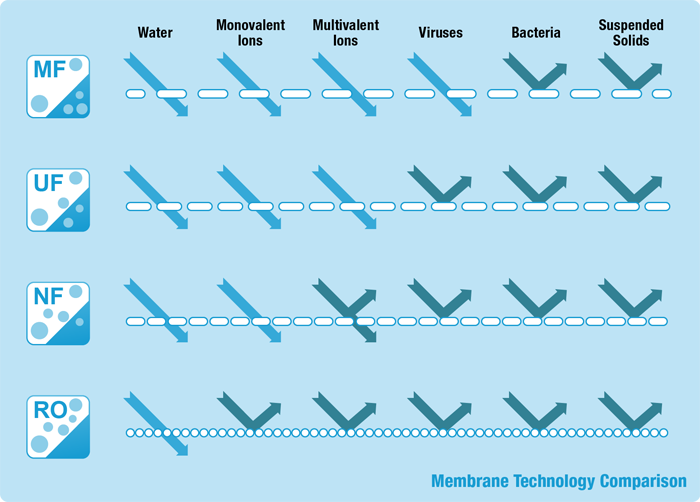
A microfiltration filter operates at relatively low pressures and has a pore size of approximately 0.1 micron (pore size ranges vary by filter from 0.05 micron to 5 micron) and have a very high effectiveness in removing protozoa (ie. Cryptosporidium, Giardia); a moderate effectiveness in removing bacteria (e. Campylobacter, Salmonella, Shigella, E. coli); but is not effective in removing viruses (ie. Enteric, Hepatitis A, Norovirus, Rotavirus) or removing chemicals.
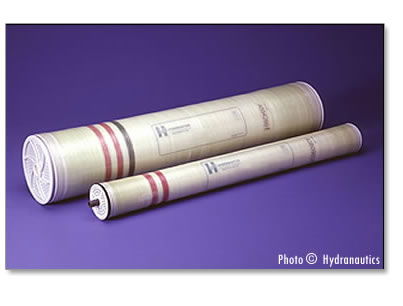
Ultrafiltration is the physical clarifying and decontaminating of water (removal of bacteria, viruses, algae, pollen, etc.) by passing it through porous, hollow-fiber PVDF membranes that hold back all unwanted particles.
Imagine, if you will, a large cartridge filled with bundles of long rubbery straws (membrane tubes) with dirty water on the inside or outside (process varies) of each straw, and clean water on the other.
Cleaner water passes through the membranes while certain contaminants are held back (based on pore size), then routinely back-washed by reversing the process (along with bursts of air to loosen the debris) and then discharged.
Ultrafiltration filters operate at relatively low pressures and have a pore size of approximately 0.01 micron (pore size ranges vary by filter from 0.001 micron to 0.05 micron; Molecular Weight Cut Off (MWCO) of 13,000 to 200,000 Daltons).
Ultrafiltration filters remove particles based on size, weight, and charge. They have a very high effectiveness in removing protozoa (ie. Giardia, Cryptosporidium) and bacteria (ie. Campylobacter, Salmonella, Shigella, E. coli); a moderate effectiveness in removing viruses (ie. Enteric, Hepatitis A, Norovirus, Rotavirus); and a low effectiveness in removing chemicals.
Nanofiltration filters have a pore size of approximately 0.001 micron (ranging by filter from 0.008 micron to 0.01 micron; Molecular Weight Cut Off (MWCO) of 200 to 2000 Daltons) and remove particles based on size, weight, and charge.
Nanofiltration has a very high effectiveness in removing protozoa (ie. Cryptosporidium, Giardia); bacteria (ie. Campylobacter, Salmonella, Shigella, E. coli); viruses (ie. Enteric, Hepatitis A, Norovirus, Rotavirus); and a moderate effectiveness in removing chemicals.
Please contact us whenever you need replacement parts for any type of water purification system component, regardless of manufacturer. Simply give us the part number and we'll provide you with a quote for your consideration and arrange delivery upon acceptance.
Kindly note that we do not design, manufacture, engineer, or service water treatment systems. Our business is focused solely upon offering you very low prices on consumables and repair parts for existing commercial and industrial OEM water purification systems, regardless of the application.
Our California office is open Monday through Friday from 8:00am to 5:00pm Pacific Standard Time, but you can write to us anytime and we'll get back to you as soon as possible, often after-hours, because we know that emergencies happen. We will ship worldwide with the exception of high fraud risk countries.
One of our goals is to continue to offer our customers the most up-to-date water treatment equipment and technology. So, if you are a water treatment component manufacturer looking for an established filtration parts and consumables wholesale distributor for your product line, or a procurement company seeking "women owned small business" bids for the government or an equal opportunity based publicly-traded corporate client, give us a call. We'd love to hear from you.